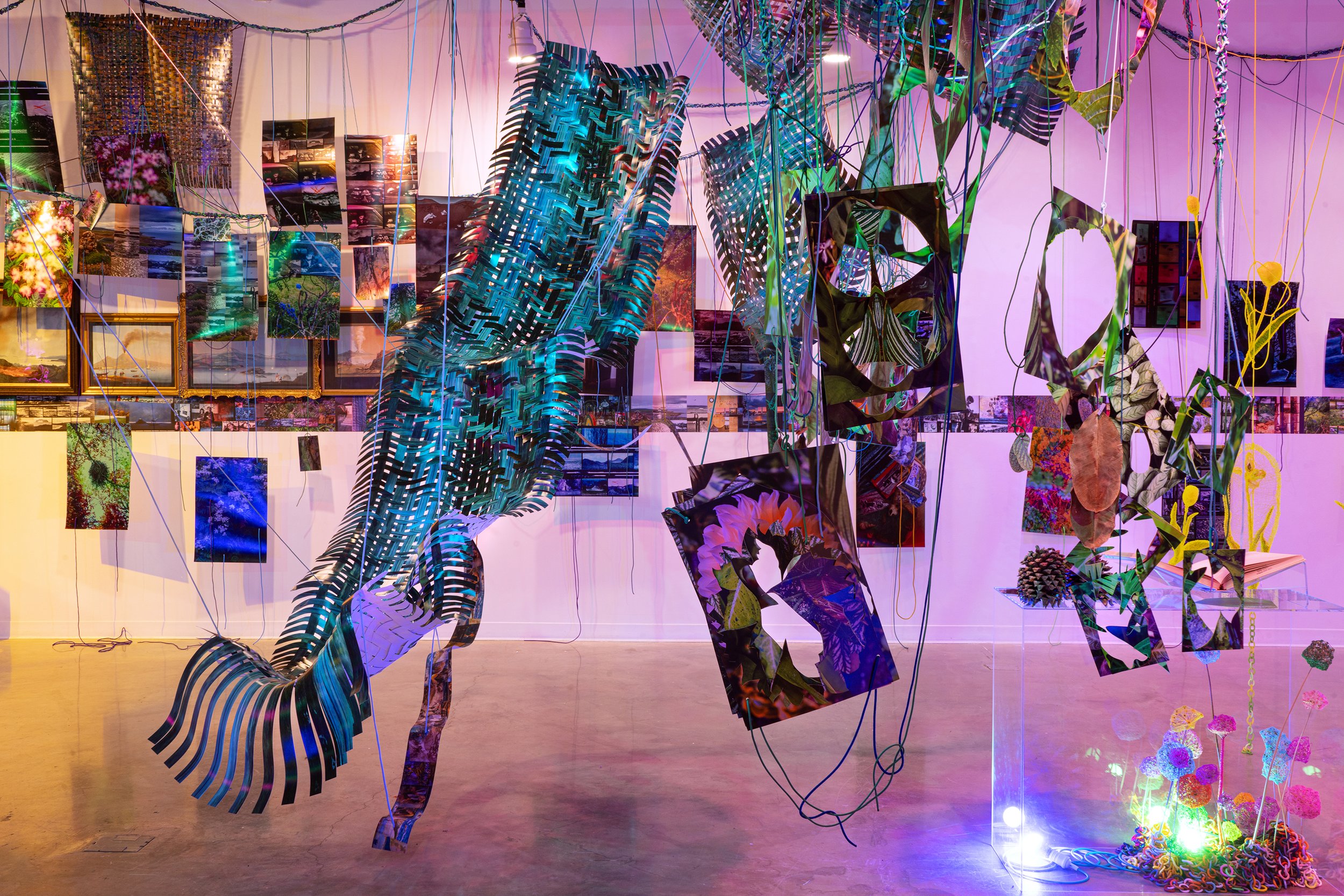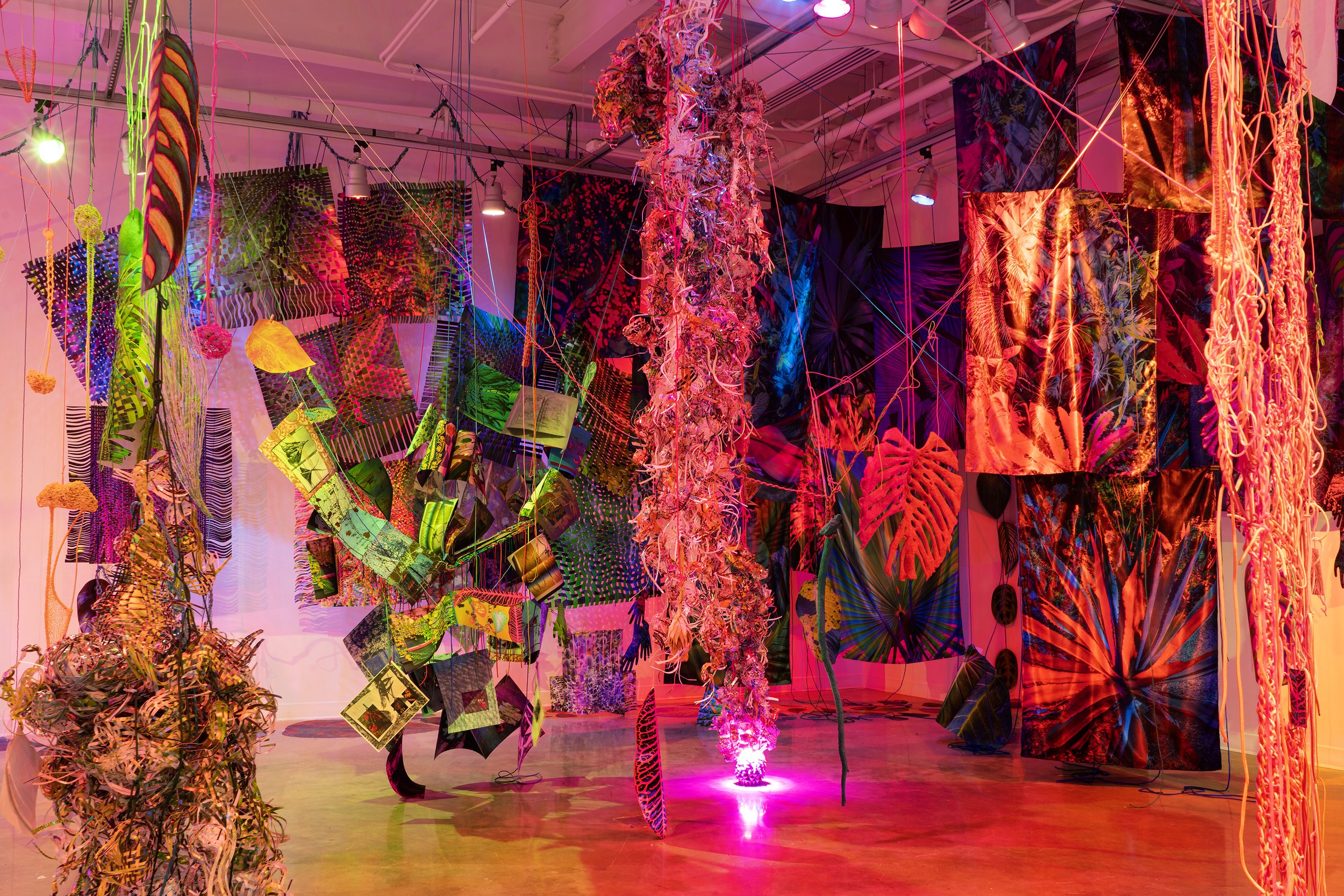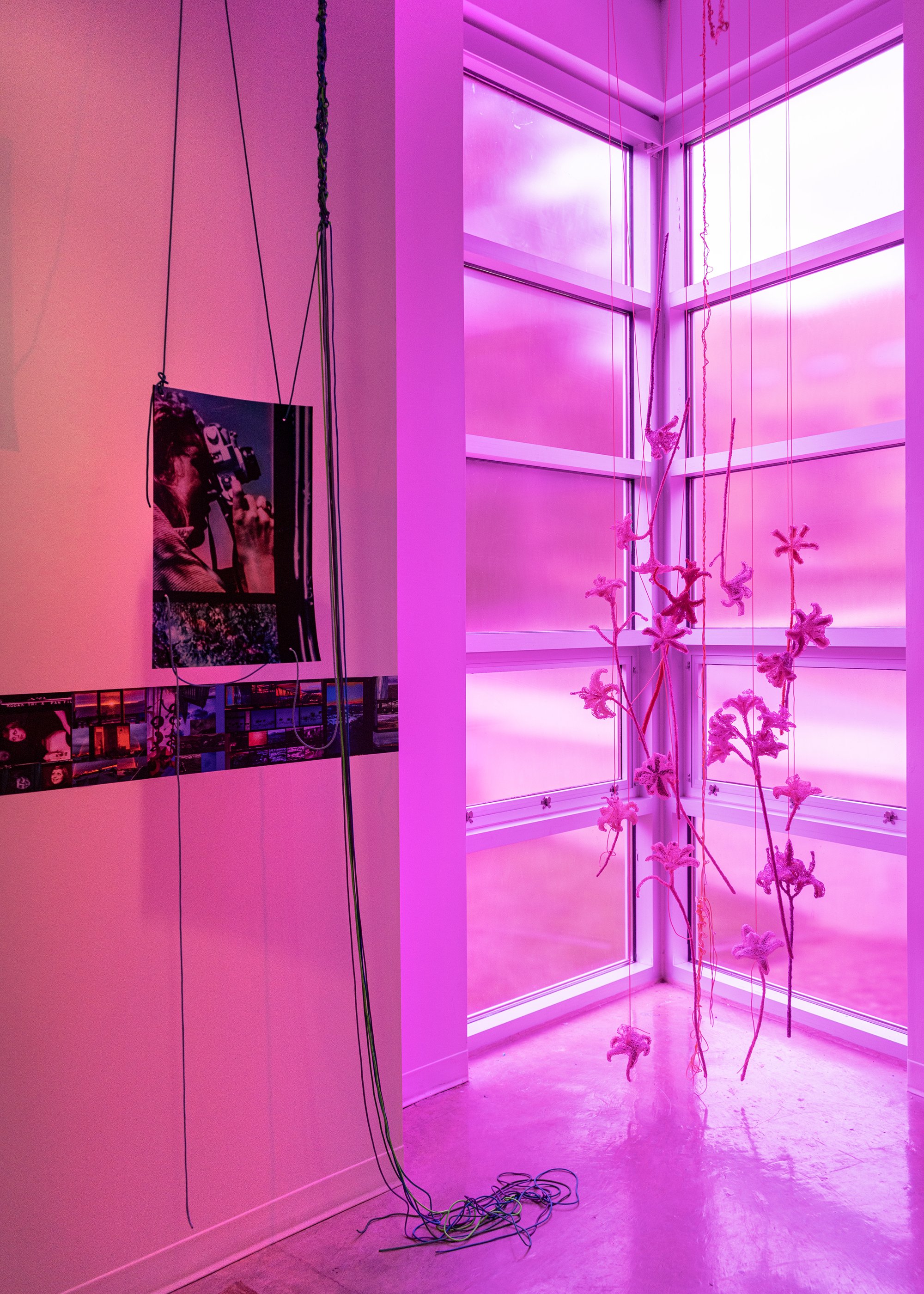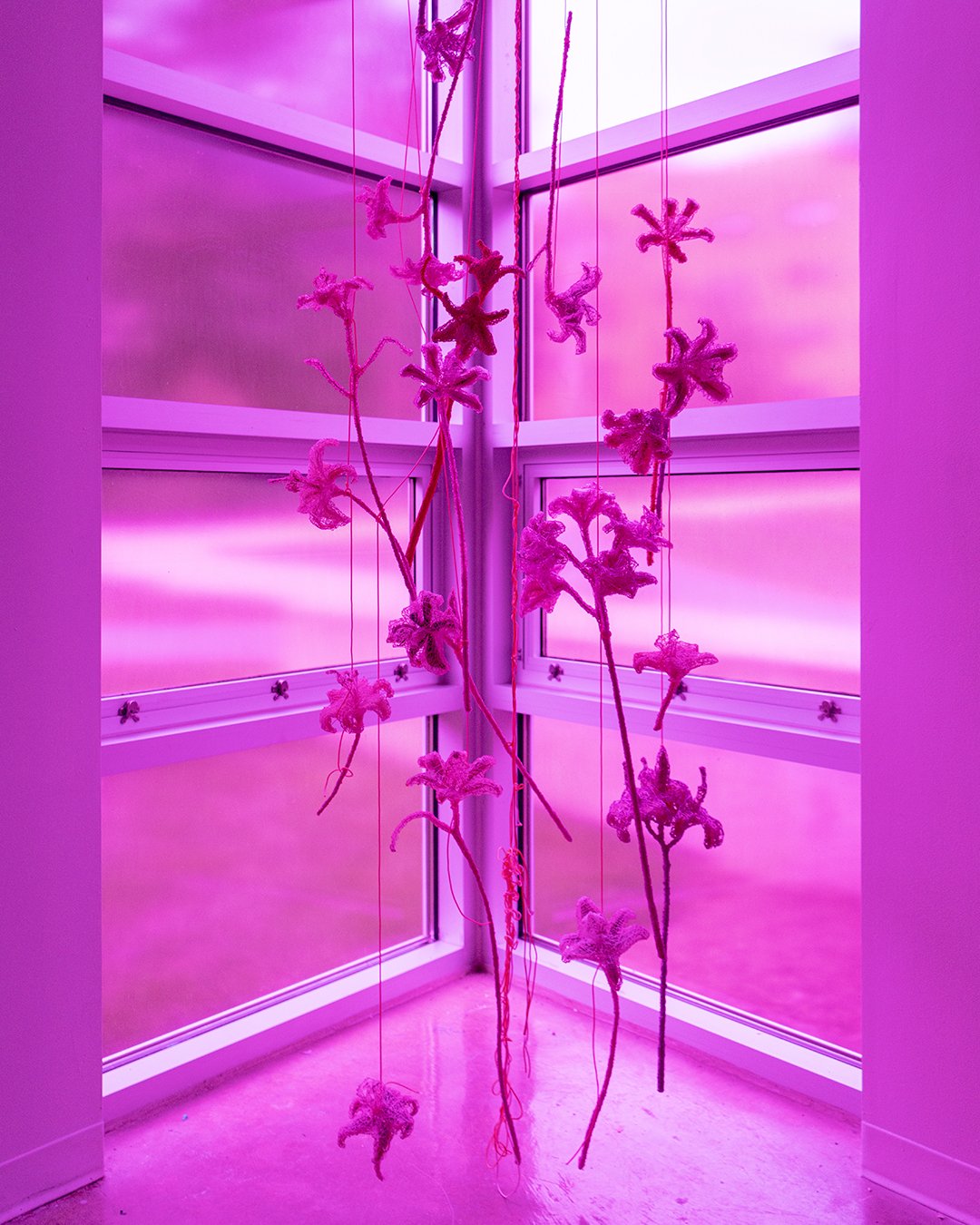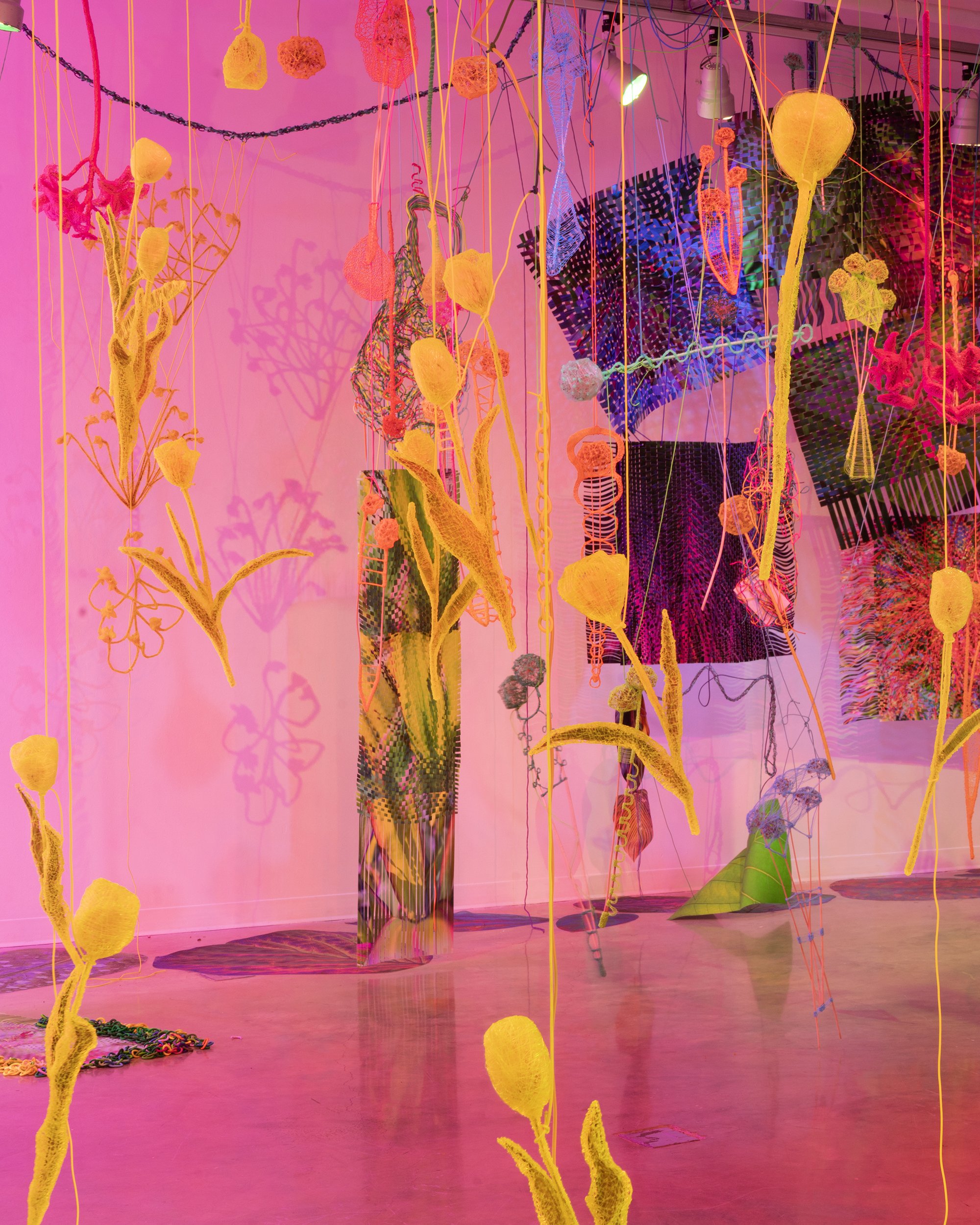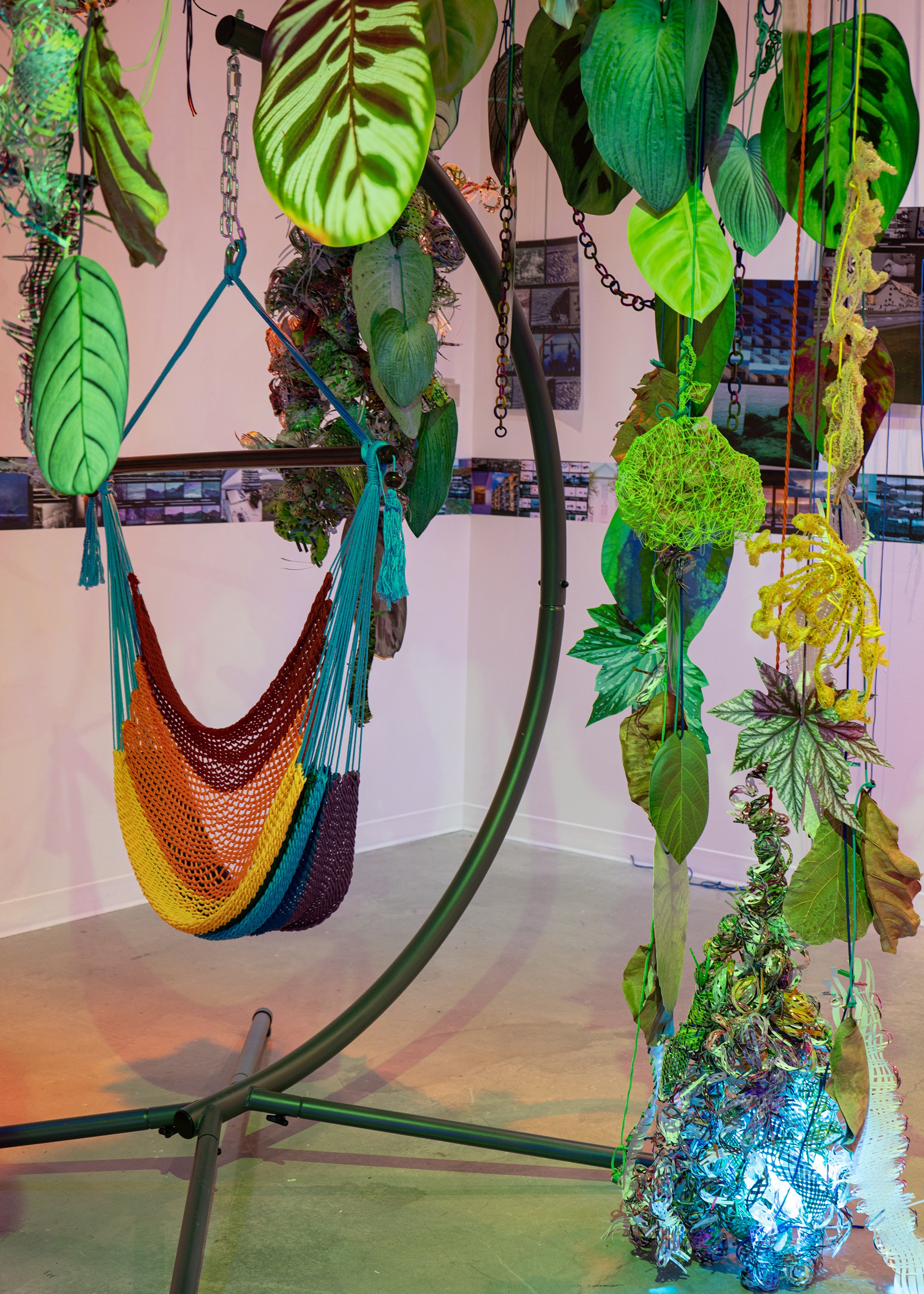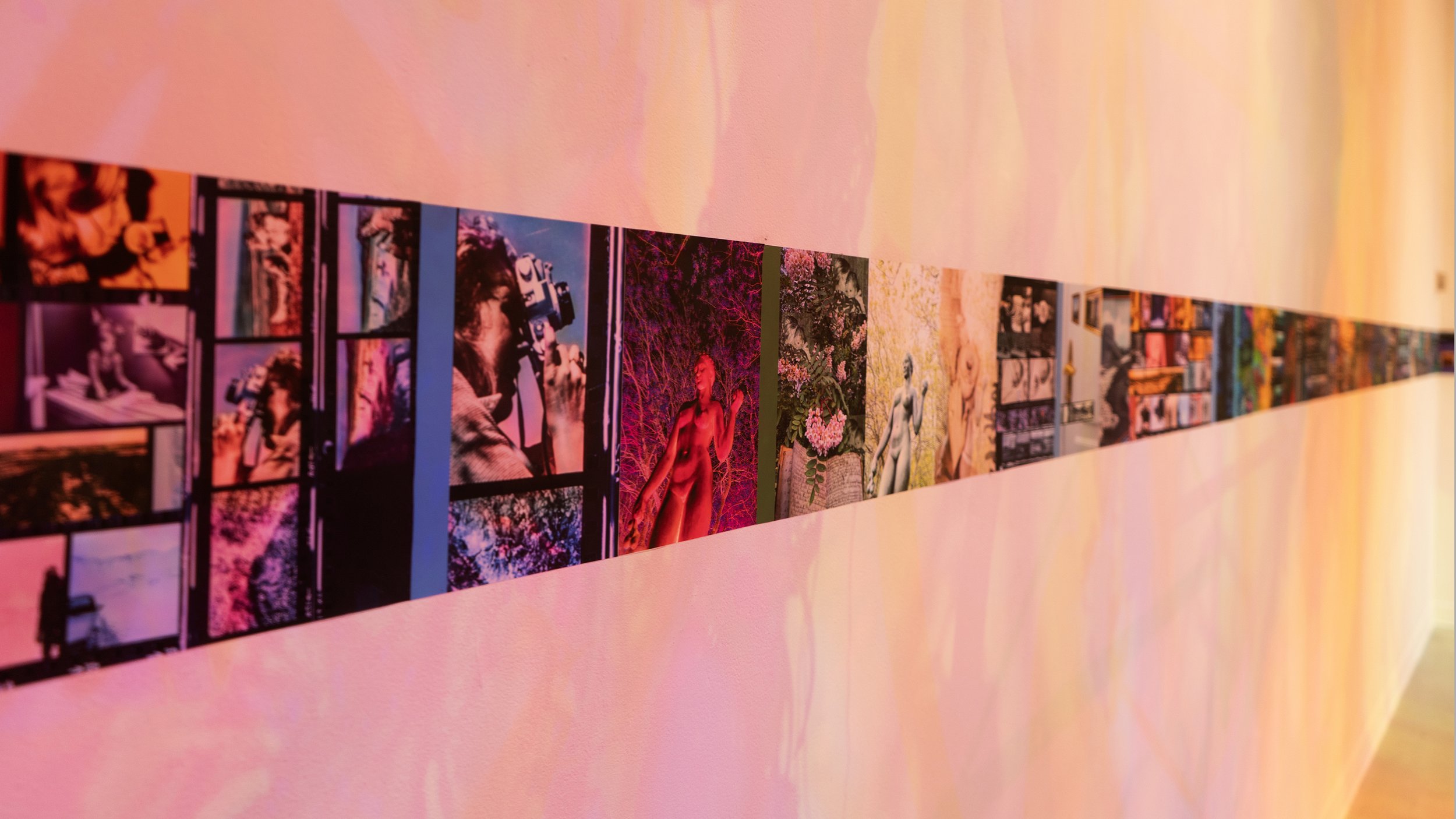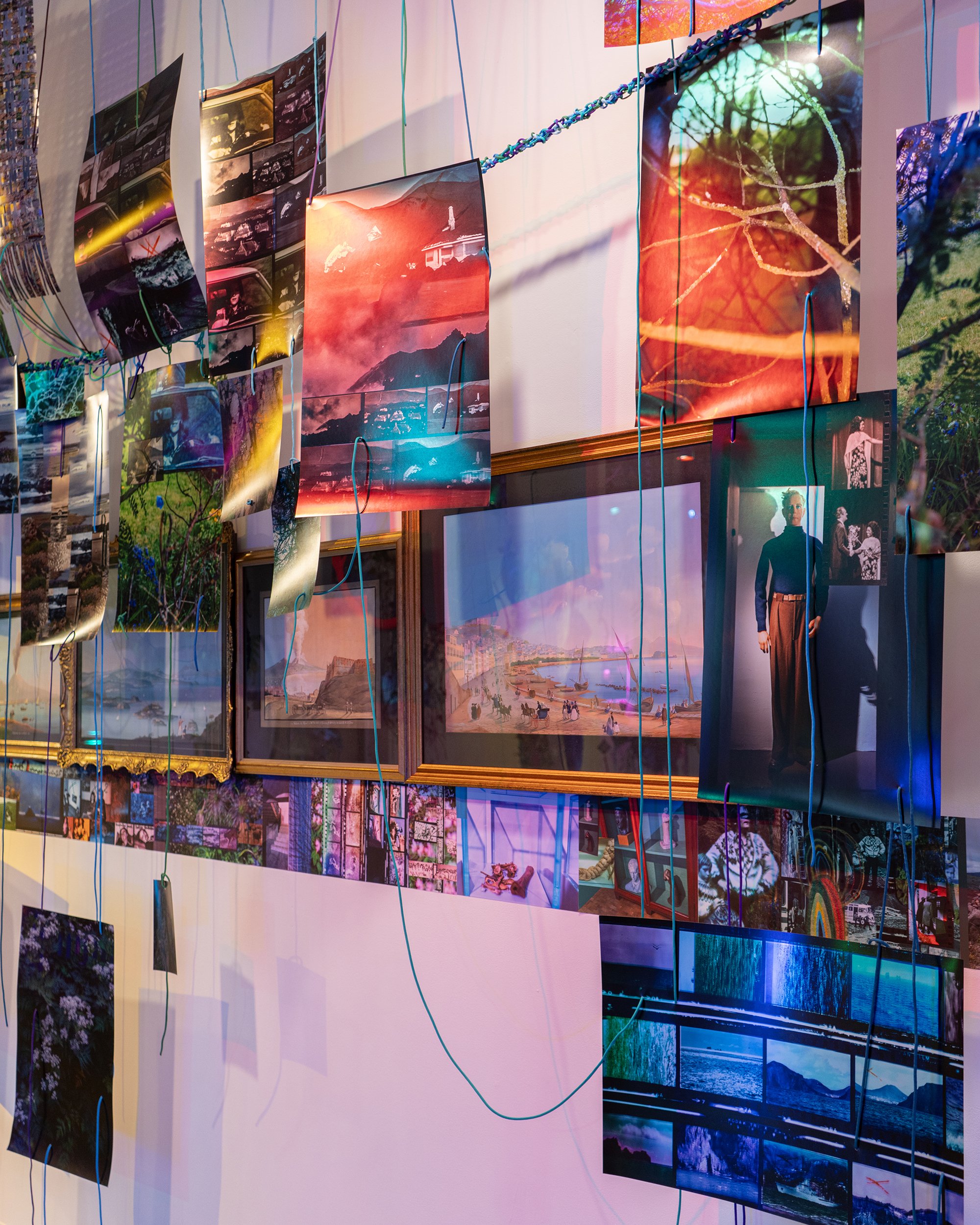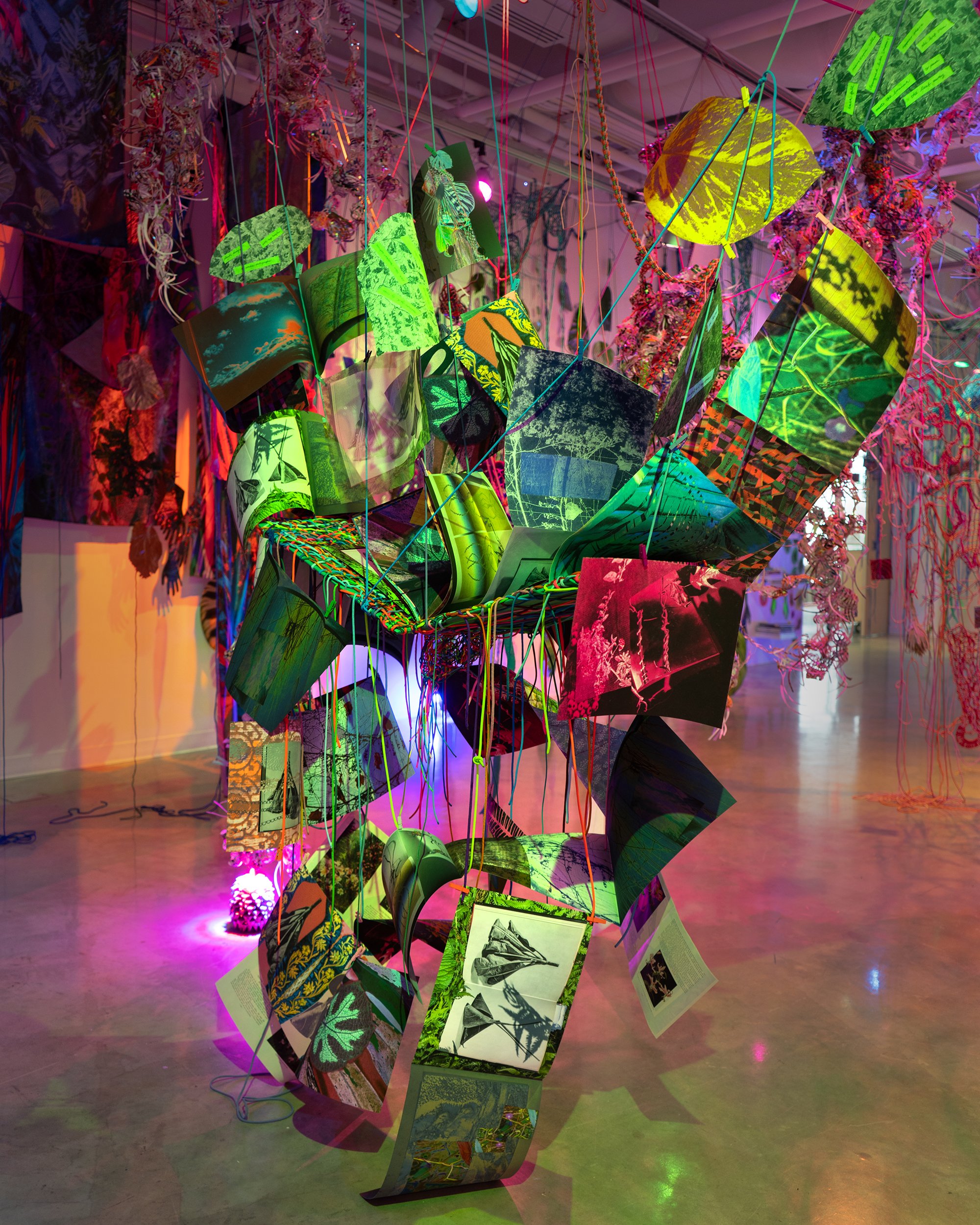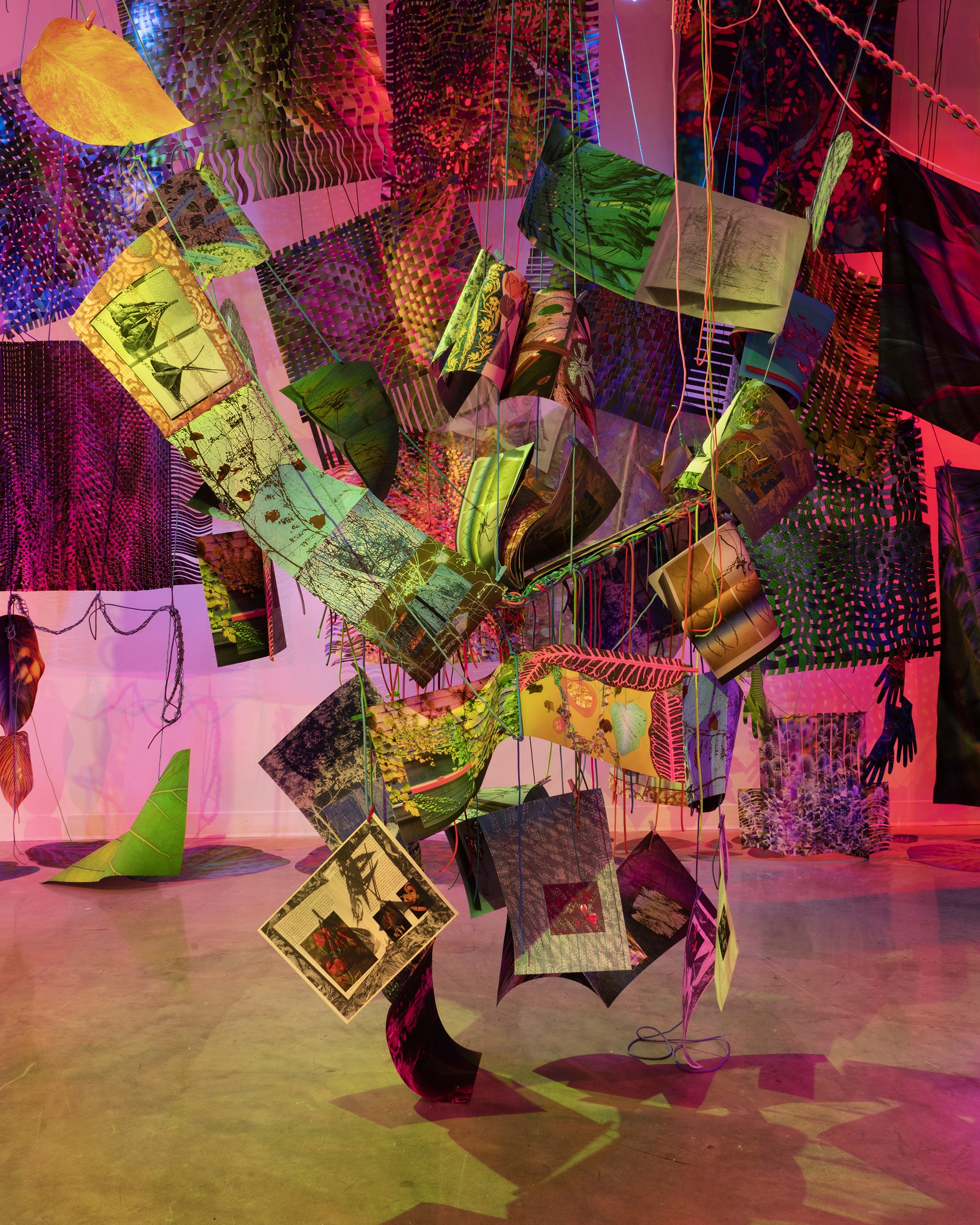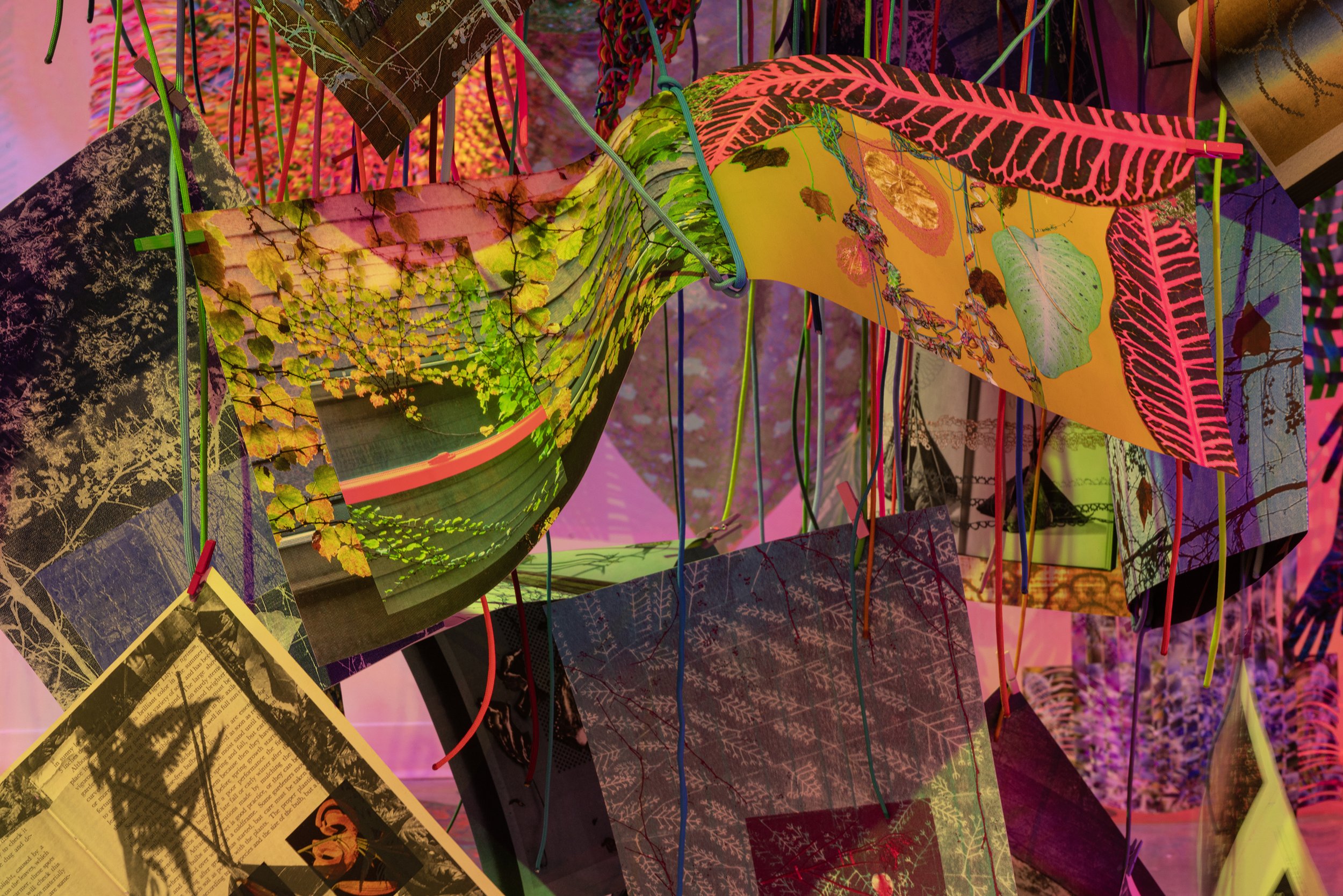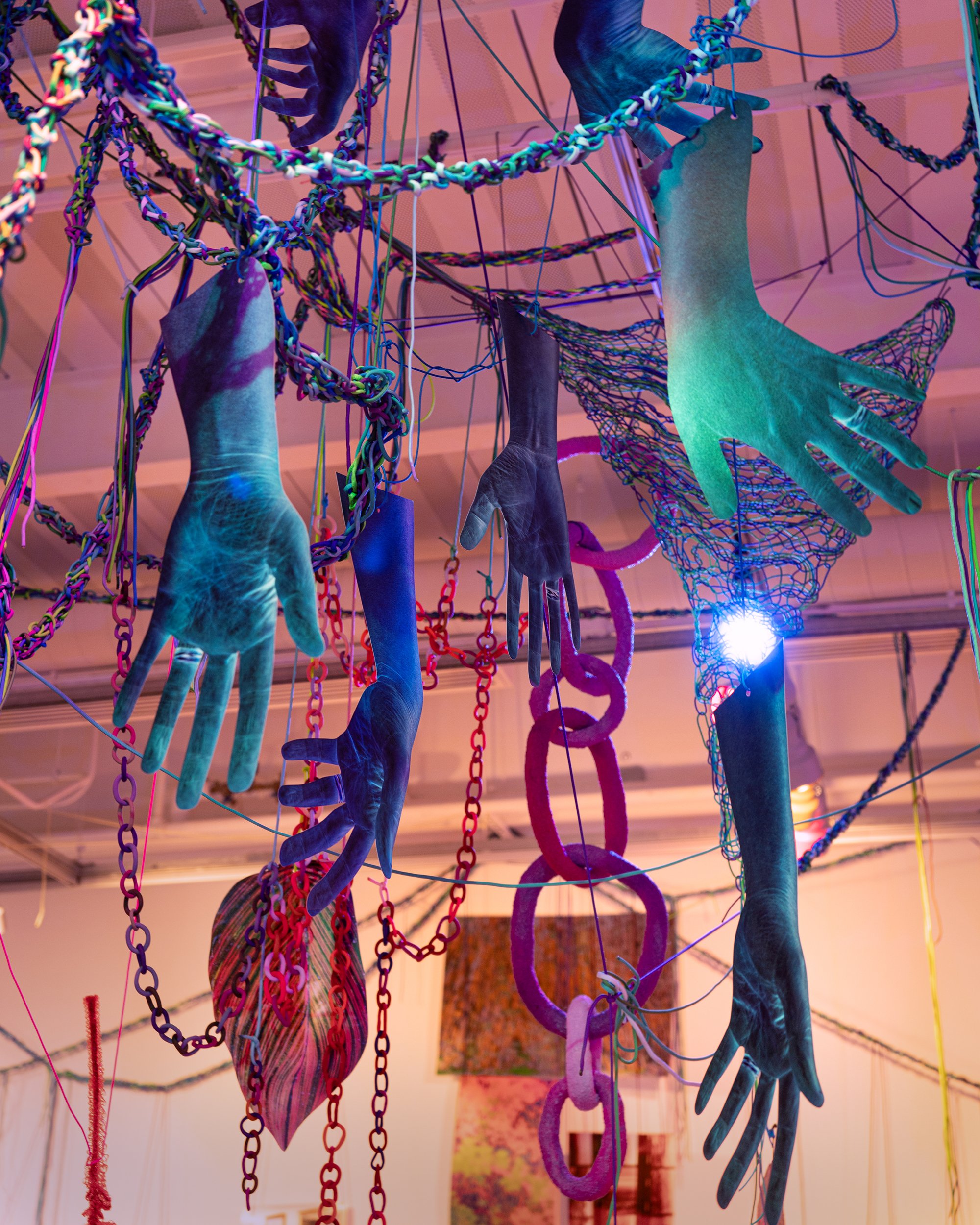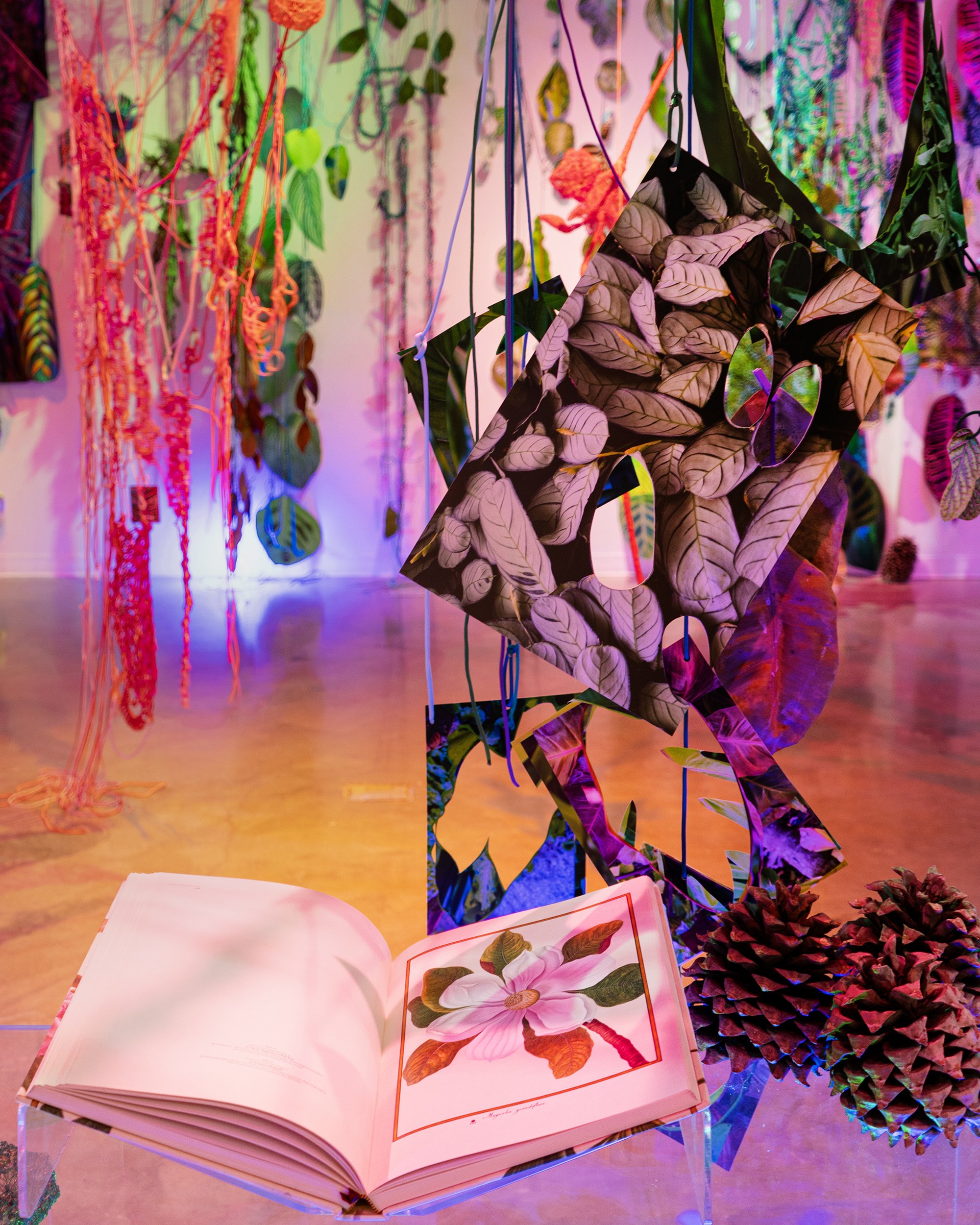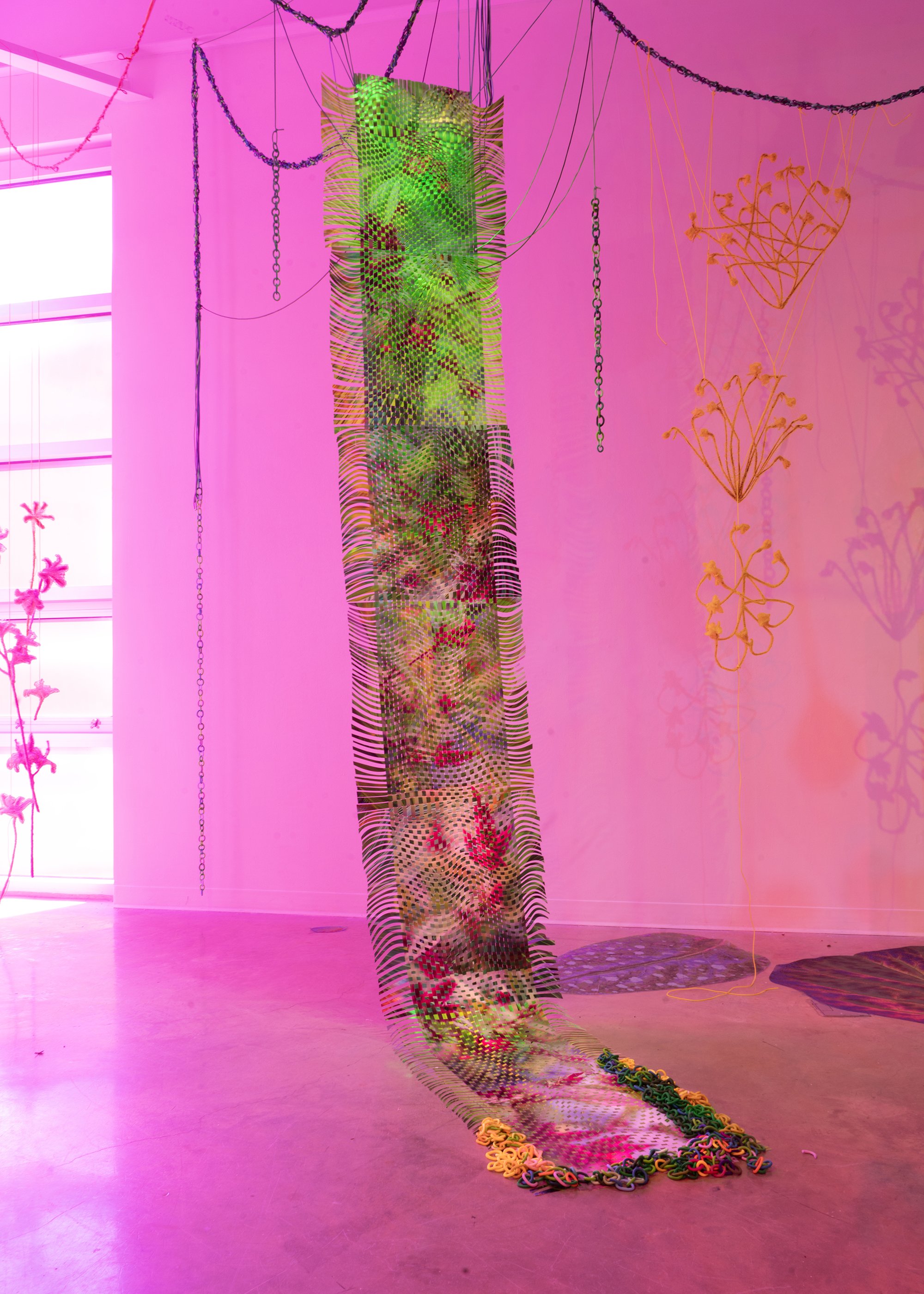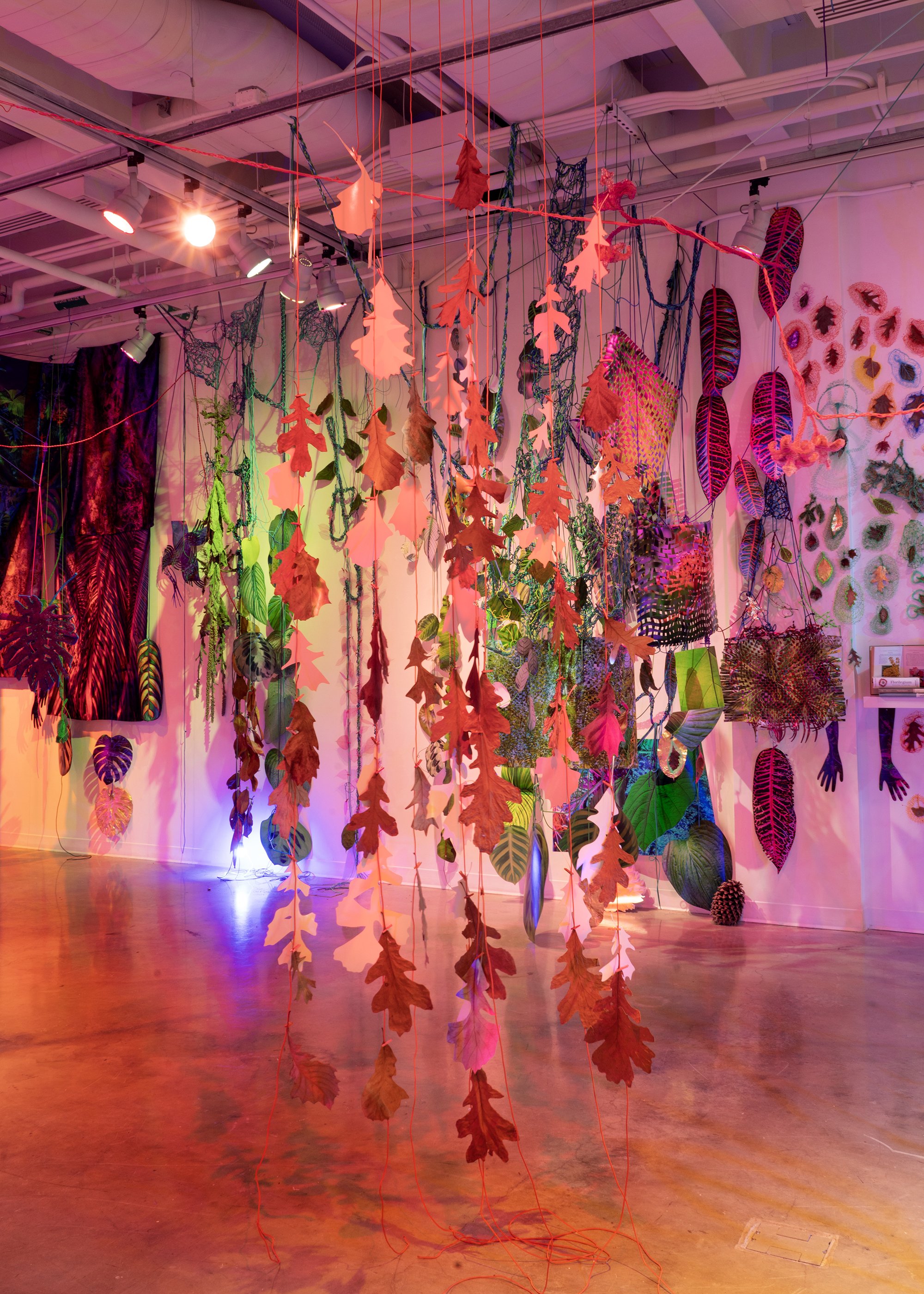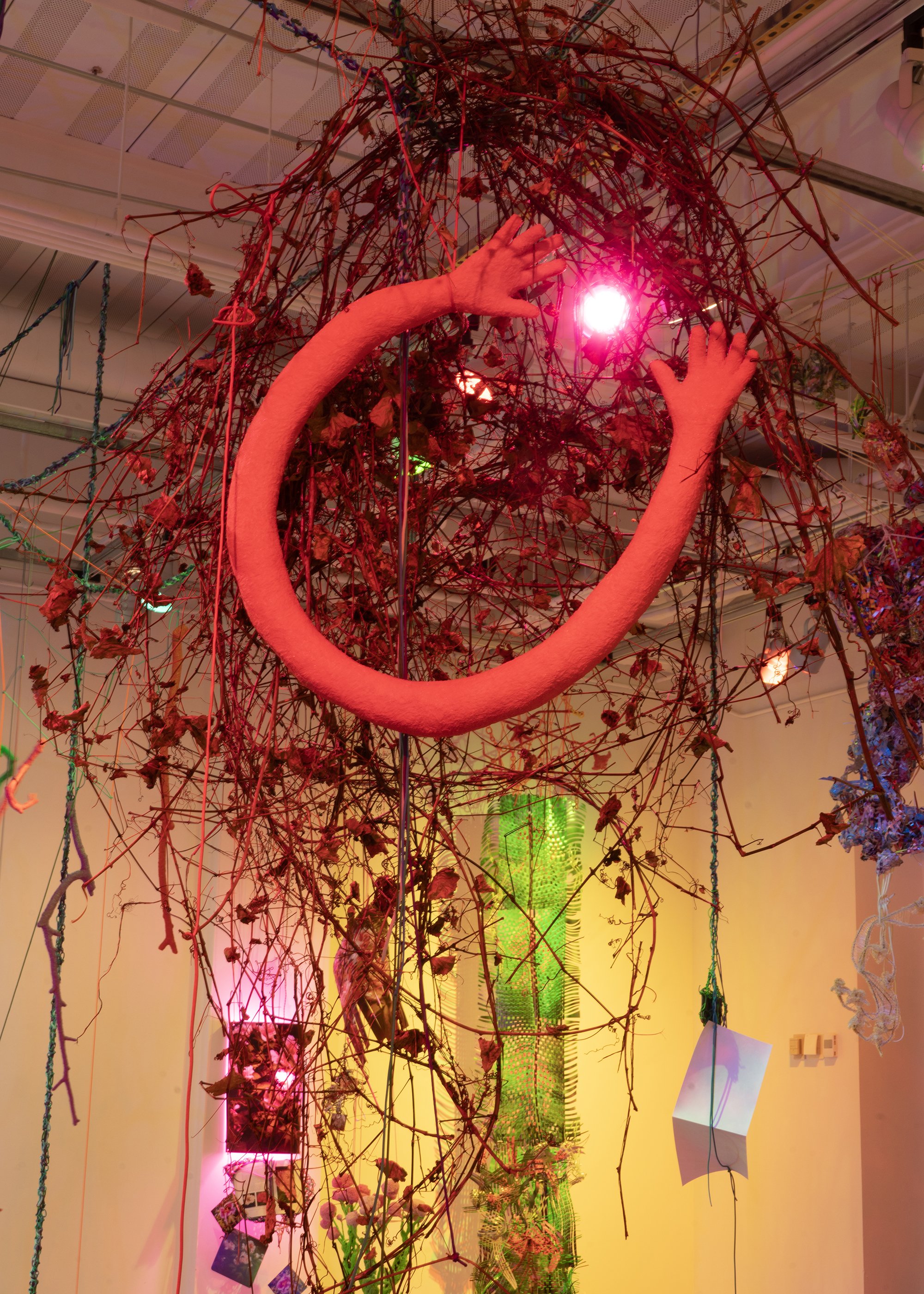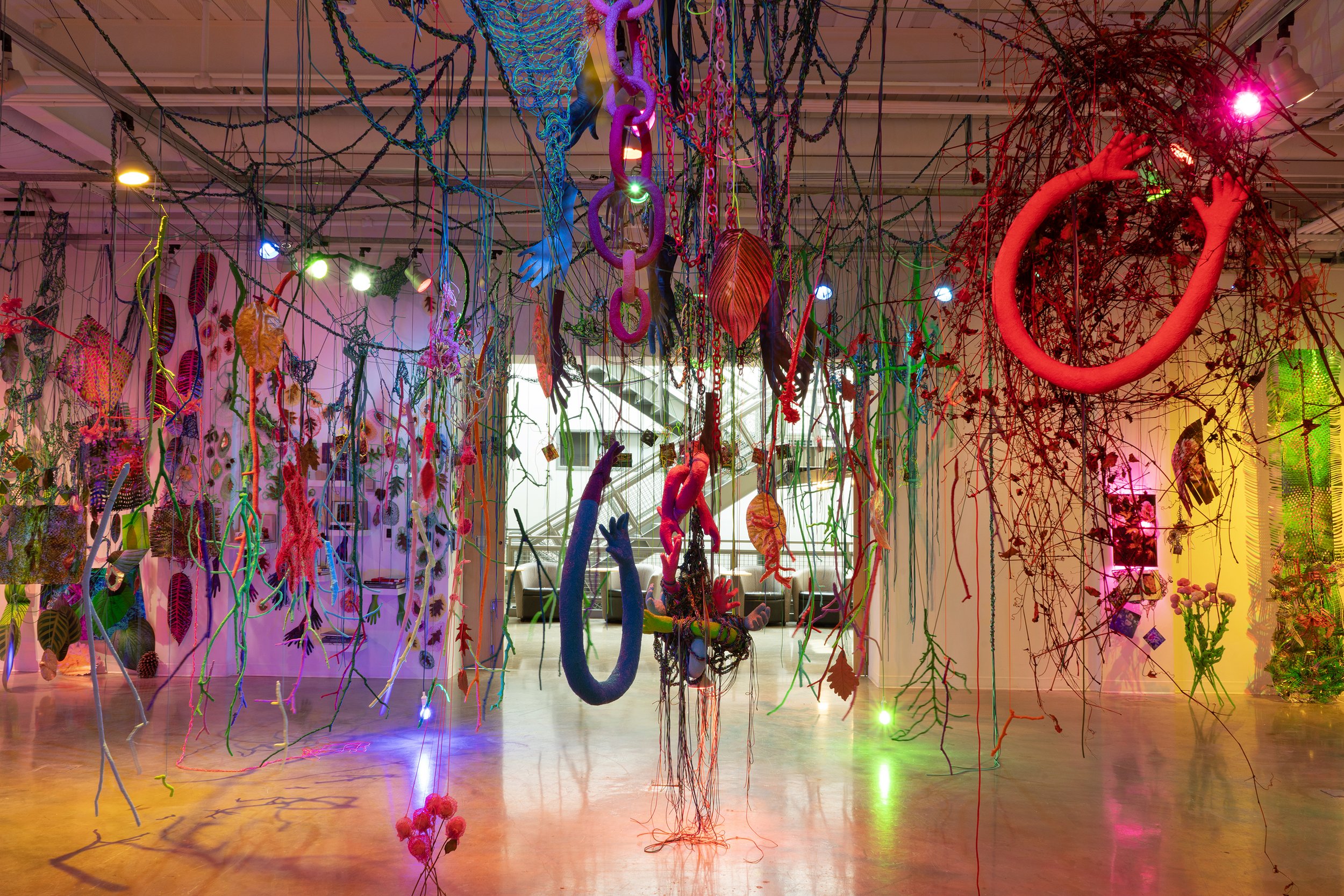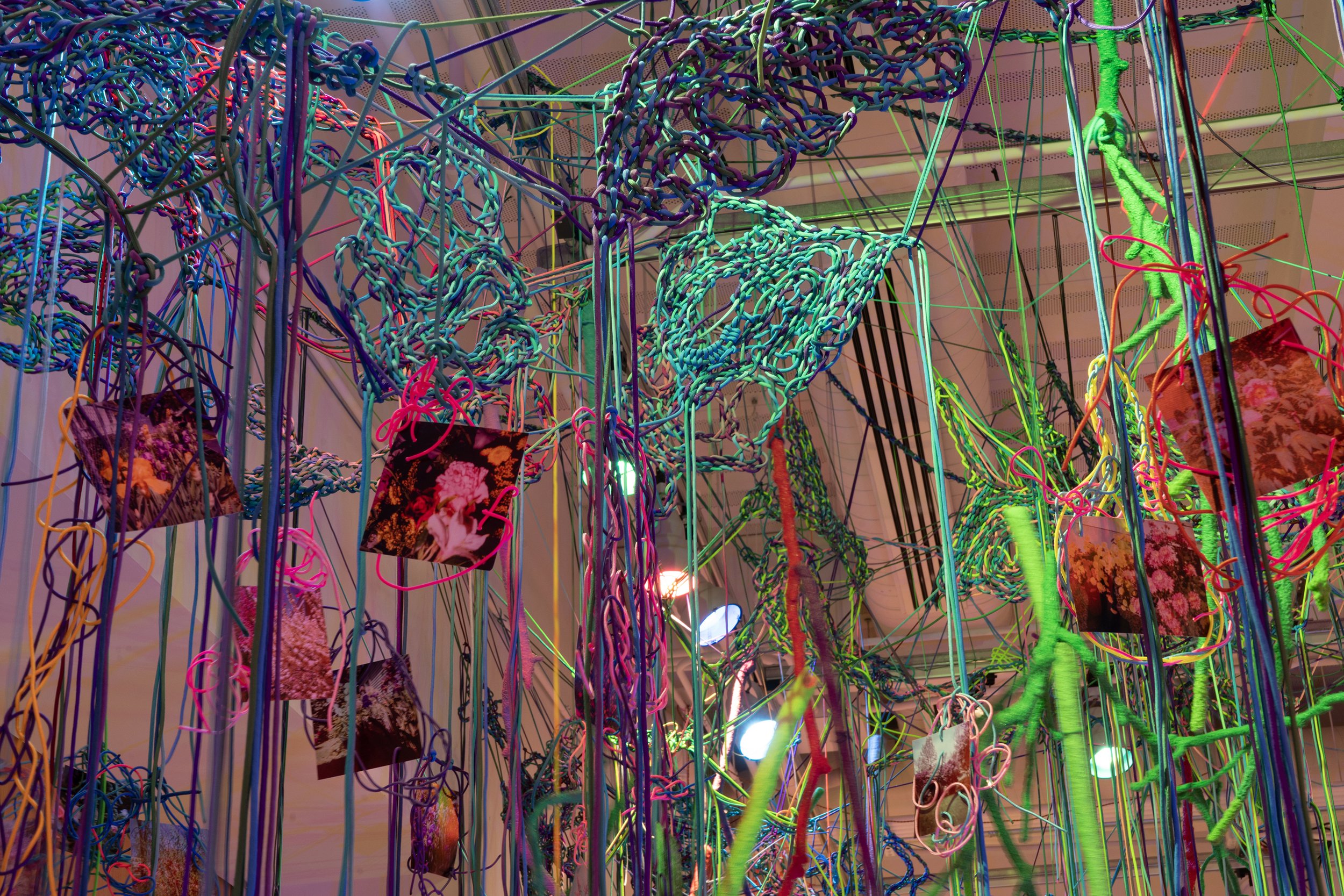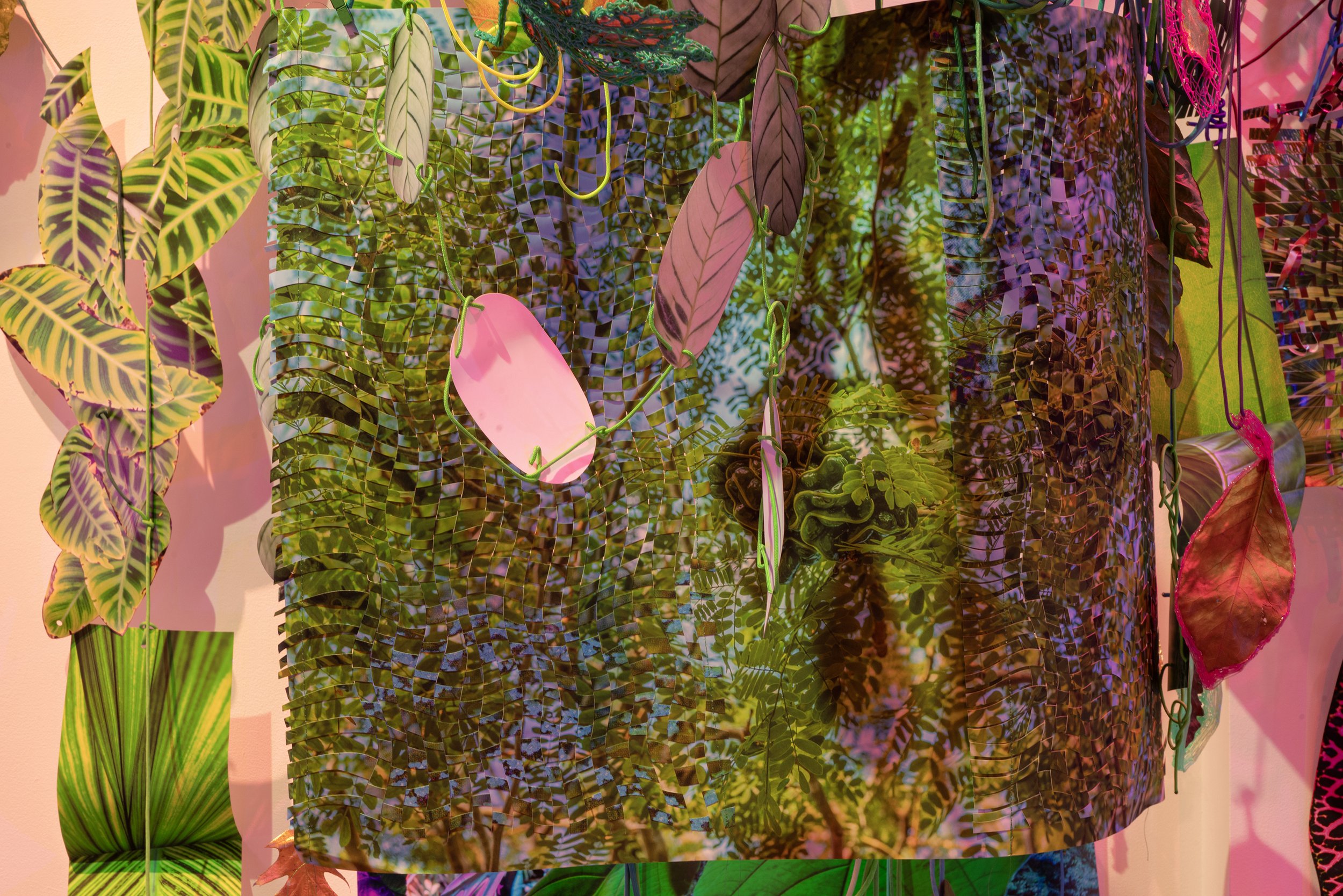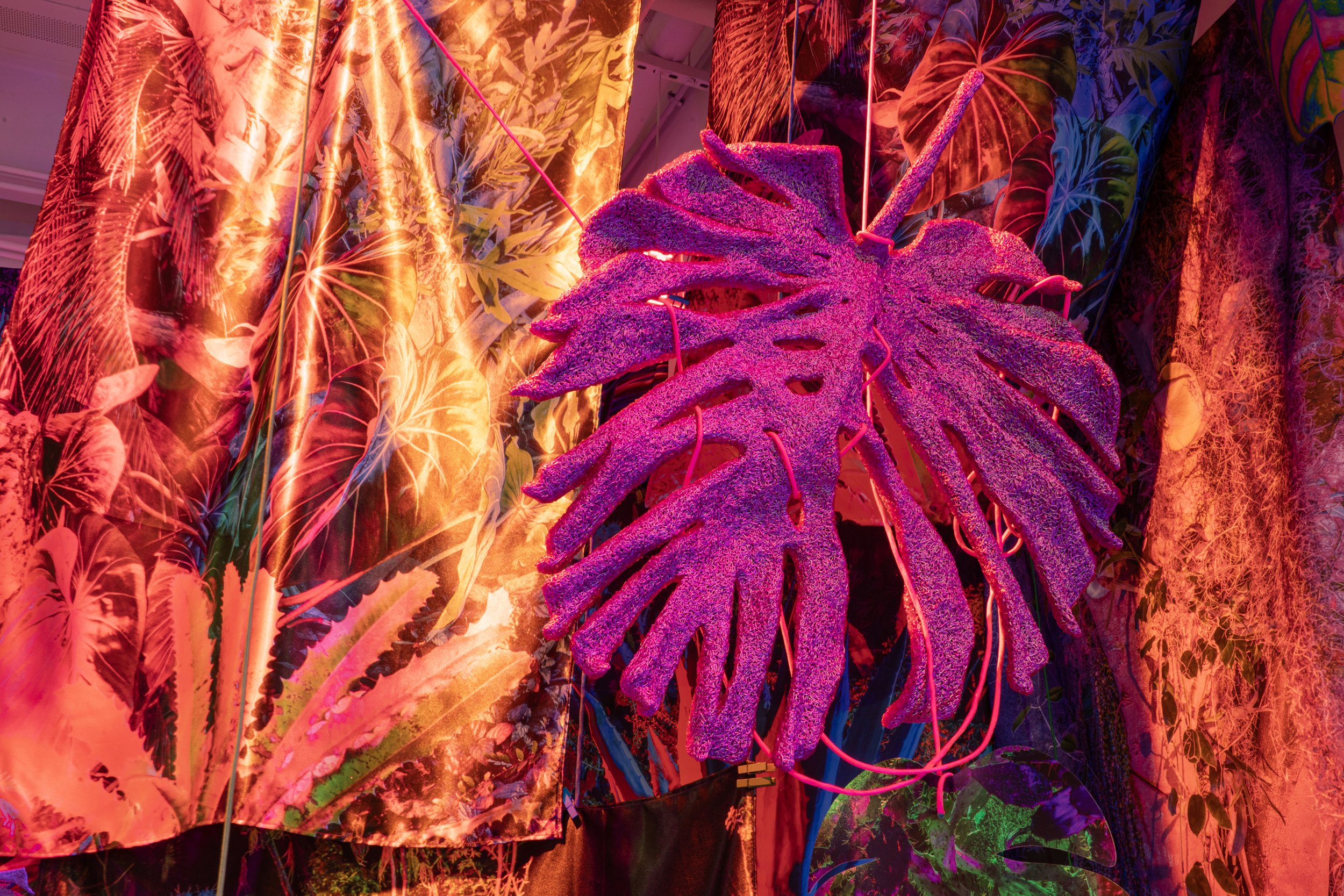AIMÉE BEAUBIEN: INTO THE HOTHOUSE
/Aimée Beaubien: Into the Hothouse
August 21 - November 10, 2023
Gillespie Gallery of Art
Curated by Jeffrey Kenney
Into the Hothouse invites viewers to contemplate the intricate connections between photographic images, the natural world, and the complexities of visual representation through an immersive site-specific installation.
Suspended throughout the 2,000 square foot gallery space, the exhibition is a category-defying constellation of dozens of gathered, printed, and hand-made works that model, depict, or present botanical and environmental subject matter including intricately manipulated photographic materials and objects representing leaves, and flowers, vine and web-like textile configurations, and bio-plastic encased dried botanical specimens. Natural forms, technological interventions, and laborious craft techniques abound. The installation is a purposely hybrid environment offering a range of interpretations. Modeling our mixed-up relationship to the natural world, Beaubien’s work cultivates both the pleasure of exploring an enchanted garden while its artificiality gestures toward the tension and confusion at the center of our distorted relationship with the ecological world.
Experimentation and Preservation
Experimentation lies at the heart of Beaubien's artistic practice. She embraces the malleability of photographic images, pushing the boundaries of the medium by transforming them into sculptural forms. Traditional craft textile techniques such as weaving, knotting, and knitting figure into her approach to form. Through cutting, reassembling, and weaving photographs together, she challenges conventional notions of foreground, middle-ground, and background, blurring the distinctions between representation and abstraction, image and material. This meticulous process of translation, revision and reassembly, transcends the confines of traditional representation and fosters a network of impressions that foreground relations between reality and artifice, viewer and environment, and a sense of interconnectedness between the natural and anthropocentric.
The depiction of time and memory emerge as recurrent themes within Beaubien's work. Present in the installation are nods to preservation and archiving implicit in the apparatuses of the hothouse, herbarium, and photographic medium. Among the many diverse photographic styles and printed surfaces, Beaubien often concentrates her camera and collecting instincts on botanical subjects and landscape imagery captured in a casual style emphasizing her personal and subjective view. Snapshots proliferate throughout the exhibit, distilling the momentary and emphasizing the chance encounter.
The light touch of the snapshot and the photographic impulse to capture and retain extend to many of the sculptural flourishes in the exhibit. One of Beaubien’s preferred sculptural methods is to encase botanical specimens such as flowers, leaves and branches in a biodegradable PLA plastic filament, extruded through a 3d pen. Using this device and a vibrant range of hues, the artist meticulously “draws” onto cuttings from her garden and organic material found in her surroundings. The results can vary from dense candy colored fossil-like branch forms or allium plants embedded in neon tracery that recalls the mathematically faceted forms of mid-century visionaries like Buckminster Fuller or Naum Gabo. This method also conjures the intricate and delicate lacelike structures found in nature such as silkworm cocoons and spiderwebs. Adding to the strange fascination of these sculptural interventions, extruding thin plastic webs on and over the botanical specimens replicates and preserves the plant’s likeness in three dimensions, while the original withers, dries, and is entombed inside. What remains are, on the surface, whimsical pop-art infused celebrations of the floral and arboreal that close inspection reveal to be poignant memento mori. An exuberant exterior enclosing a wilted core.
Gatherings: Archive, Sequence, Collage
Beaubien employs methods of arrangement in her sculptural tableaux that are intrinsic to her practice as a maker of artist books; examples of her books are included in the exhibit. In making her photo-based original books, primary attention is given to the sequencing of images and how they unfold as an experience over time. She often deploys the improvisational methods of collage using the potential friction or coherence between similar or contrasting subjects to produce abstract narrative-like momentum or rhythmic pulses. She uses a similar logic of contrast and accretion in her sculptural and architecturally contingent arrangements in the space of the gallery. Rather than a linear movement through the pages of a book, the exhibit design allows for multiple pathways and encounters. Delicate moments of careful examination are brought into orbit with dense and sometimes chaotic compounds of image and form in which the viewer and space begin to network together. Nodes cluster and expand. Zoom, pan, focus, blur. Thickets give way to clearings, tendrils to bouquets. The body passes through, around, and between. Attention gathers, then dissipates, then gathers anew.
Beaubien’s artist book, With Inger (2018), in which she studied, appropriated, and merged her personal explorations of Iceland with the personal photographic archive from the 1970’s of an obscure Icelandic photographer named Inger Helene Boasson, is presented here as a 90 ft. long scroll-like panorama, positioning the book pages end to end. In this configuration the book pages suggest a horizon line for the rest of the installation, as well evoking a timeline, or film strip. With Inger is a kind of collaborative auto-biography and epistolary essay in images, representing the two photographers’ lives through their research activities, replete with contact sheets, snapshots and practiced attempts at creating photographic art. The works from Inger’s archive, that Beaubien remixes, are a diverse collection of her personal subjective vision and responses to her local environment, friends and loved ones, and travels through the Icelandic landscape. This subjective and free ranging approach of Inger’s practice resonated with Beaubien, whose photographic work often starts in her backyard garden but may extend to other geographies she visits for artist residencies and exhibitions. The book interweaves these two distinctly individual photographers, Aimée and Inger, though decades and continents separated. Poetically mirroring one another, their lives echo through each other, despite the distance. The resulting photo montage is a reminder of the narrative consistency that underpins human subjectivity.
Sharing wall space and overlapping sections of With Inger are eleven gilt framed 19th century gouache paintings from the Neapolitan School featuring views of Mount Vesuvius. Borrowing this historical collection of paintings from George Mason University's permanent collection and including them in the installation, Beaubien connects these pre-photographic souvenir paintings from the so-called Grand Tour to her artist residency experience in Iceland. Iceland was formed in part by volcanic activity and continues to have frequent eruptions. While on her Icelandic residency Beaubien was fascinated by the amount of volcanic imagery that she encountered in her explorations. She documents many of these illustrations in a scroll-like photograph suspended nearby in the installation.
Both the borrowed paintings and With Inger can be seen as distinct examples of a type of travelog while their display anchors this part of the exhibit in a manner recalling a museum, mixing examples across time, culture, and geography into a set of key traits. Beaubien breaks with the conventional display by overlapping images and further fragmenting potential readings by forgoing didactic information. Through these distancing techniques, Beaubien allows for a free association of imagery while throwing into relief the conventions we have come to expect from such a display.
An Enclosed World
Throughout Into the Hothouse, like many of Beaubien’s previous installations, she consciously pushes against the expectations of standard art exhibition experience. Her go-to method is to have her photos and objects suspended in space, connected by a paracord material, attached at various points throughout the gallery ceiling fixtures. This program of display mimics vines, webs and other natural phenomena while inverting the viewer’s usual relationship to sculptural objects. Rather than worrying about objects being toppled from a pedestal or keeping the viewer an appropriate distance from them, the suspension system of her sculptural and photographic tableaux allows and encourages items to move and react to light touch or being casually bumped. With Into the Hothouse, Beaubien actively courts audience interaction further by clustering a group of bio-plastic coated branch forms, photos and a dense thicket of dangling ends of paracord in the entrance of the exhibit. To enter the show, one must push through and brush up against parts of the art work. By opening up the tactile aspects of the space, releasing the viewer from the pressures of conforming to familar constraints that often undergird the gallery experience, Beaubien’s installation intentionally attempts to put viewers at ease. This freedom opens the potential of the space as a social site, inviting interaction with the artworks and with each other.
As a whole the installation has a shape and dynamic that evokes various forms of biological systems such as neural pathways, fungal networks, and rhizomatic plant growth. In this way, Beaubien’s use of highly saturated colored lighting not only adds a vivid theatricality and phantasmagorical quality to the environment, but also draws parallels to scientific imaging techniques that use advanced technological devices, such as MRI, scanning electron microscopy, or deep space telescopes. In these imaging technologies, color is used as an artificial additive or enhancement, in order to highlight and reveal properties otherwise invisible through standard observation. Adding an additional layer of technological intervention, Beaubien incorporates motors to produce subtle movements, like a mechanical wind, among some of her hanging elements. The movements are subtle, trembling and somewhat herky-jerky. The metronome-like whir of these motors reverberates through the installation, and uncannily suggest the sounds of printing apparatus or hospital room systems, projecting a sense that the exhibit is either in continual production mode or on a means of mechanically assisted life support.
The hothouse itself is a kind of technology developed as a means of life support. It is a structure designed to cultivate and protect delicate plants in a controlled environment, fostering their growth and preservation. The development of hothouses shares some historical colonial ties with the photographic medium, particularly concerning botanical collections. During the colonial era, the advent of photography coincided with the rapid expansion of botanical explorations and expeditions worldwide. As European powers sought to expand their empires, botanical collections became essential for documenting and categorizing newly discovered plant species from far-flung territories. Photography emerged as a valuable tool to preserve botanical specimens and accurately depict diverse flora from distant lands. The ability to capture high-quality images allowed botanists and explorers to share their findings with scientific communities and the general public, shaping a collective understanding of the natural world beyond colonial borders.
Metaphorically, a hothouse also connotes an environment of rapid accumulation, acceleration, or saturation. Photography and digital communication networks have now surpassed all other technologies in conditioning our understanding of the other species and the distinct geographic regions that compose the earth. Tying the photographic impulse to historical programs of science and economics has enhanced the endless drive to understand, dissect, transform, and extract information from the tangled and interdependent contours of life. As a result, we have conscribed much of our appreciation of “the natural world” to image, text, and resource.
Despite the hyper stimulating quantity of competing images, colors, and tangles of form, Beaubien’s exhibition exudes a quiet magic and generosity of spirit. The artist is a world builder. Her environments project a sense of wonder through an overflow of intentionality and a condensing of idiosyncratic creative impulses. On display are over ten years of her creative output. This retrospective of sorts presents a fascinating view of her artistic project as it continues to evolve. Into the Hothouse, is by equal turns entertaining, experimental, and playful. It is also seriously engaged in a provocative inquiry, boldly embodying the fraught dynamics between nature and artifice in our media-saturated age.
A Conversation Between the Curator and Artist
ABOUT THE ARTIST
image credit: Liz Louise Johnson
Aimée Beaubien is an artist living and working in Chicago. Beaubien reorganizes photographic experience while exploring networks of meaning and association between the real and the ideal in collages, artists books and immersive installations. Her work has been exhibited widely, including SF Camerawork, San Francisco, CA; Art Institute of Chicago, Chicago, IL; Museum of Contemporary Photography, Chicago, IL; Houston Center for Photography, Houston, TX; Gallery UNO Projektraum, Berlin, Germany; Marvelli Gallery, New York, NY; Virus Art Gallery, Rome, Italy; Demo Projects, Springfield, IL; The Pitch Project, Milwaukee, WI. Aimée Beaubien is an Associate Professor of Photography at the School of the Art Institute of Chicago, IL where she has taught since 1997.
Event Recordings:
Mason Exhibitions and the Cheuse International Writers Center are pleased to welcome you to an Eco-Poetry Reading at Gillespie Gallery of the Art and Design Building at George Mason University.
Dr. Krista Hiser and Dr. Michael Svoboda share a common interest in climate fiction and film. The exhibition got them thinking about the different impact of climate change in reading and in watching: in books and in films. So, they met to have an informal conversation!

